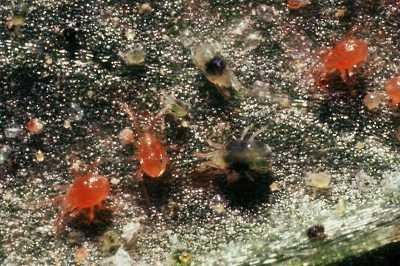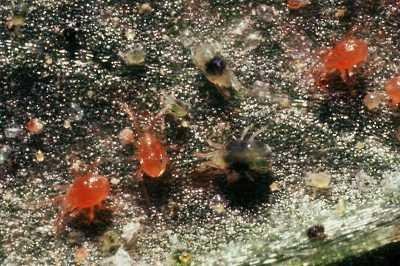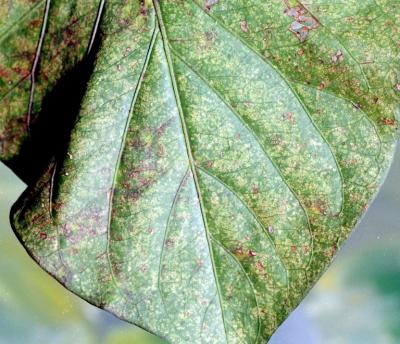


Tea mites and spider mites
Mites are among the major pests of tea. Sporadic yield losses in the affected areas in Kenya are estimated to be about 50%. Growth of young tea is reduced by mites by about 30%.
1) Red crevice tea mite (Brevipalpus phoenicis)
They are also known as the false spider mites or the scarlet mites. They attack leaves of all ages, distorting them. They feed on the undersides of leaves, especially between the main veins at the petiole end. Corky areas are formed on the underside of leaves, especially between the main veins at the petiole end of leaves; attacked leaves may dry up and be prematurely shed; they may cause serious defoliation, resulting in reduced yield.
Numerous tiny red mites can be seen in the bark crevices of the new wood. A few bushes may be heavily attacked, leaving the majority almost free from attack. This mite is a major pest of tea, causing heavy damage especially in prolonged drought. It occurs in all growing areas in Kenya, being serious around the Mount Kenya region (Sudoi et al., 1994).
2) Tea red spider mite (Oligonychus coffeae)
It is also called red coffee mite. It may cause considerable losses to tea production. Mite attacks are usually confined to few bushes. These mites are reddish brown and purple. They feed together on the upper surfaces of the leaves, the cast skins of the immature stages remain stuck on to the leaf and maybe seen with the unaided eye as irregular white spots. The upper surface of fully hardened leaves turns yellowish brown, rusty or purple colour. If the tea bush is under drought stress, flush leaves may also be attacked. They usually prefer older leaves but in heavy infestations younger leaves maybe attacked. This mite has been recorded in all tea growing areas in Kenya in low to moderate infestations (Sudoi, 1991).
For more information on Spider mites click here.
3) Yellow tea mite (Polyphagotarsonemus latus)
It is also known as broad mite. It is a minute mite yellowish to whitish in colour and cannot be seen with the naked eye. This mite is a sporadically serious pest in tea nurseries, and has been reported as a common pest of tea in Tanzania (Bohlen, 1973).
Attacked leaves remain small, are crinkled, or otherwise distorted with corky brown areas between the main veins on the underside of the leaf. The plants are severely stunted in case of serious infestations.
- Use neem extracts in emergencies. Sudoi (1998) found that although neem seed oil at a rate of 0.03% was not satisfactory on contact against the tea red spider mite, direct application on the pest at 2.5% significantly reduced its survival. Thus, he considered that neem products have potential against spider mites in tea nurseries and in the field. In India, neem oil and commercial neem products ('Neemguard', 'Repelin' and 'Biosol') significantly reduced broad mites on chilli (Ascher et al., 2002).
- Till weeds early enough before the main harvest begins.
- Use resistant clones, if available. It has been observed that certain clones suffer more attack by red spider mites than others during an outbreak of the mites. Thus, clone "7/9" is less suitable for red spider mite development. Certain clones, like "SFS 150" and "6/8", exhibit resistance to the red crevice tea mite (Sudoi, 1992).
- Provide good growing conditions, healthy plants are more likely to withstand mite attack. Studies in the Eastern Highlands of Kenya showed that nitrogen fertilisation increased plant vigour and induced tolerance to attack by the red crevice mite (Sudoi et al., 2001).
